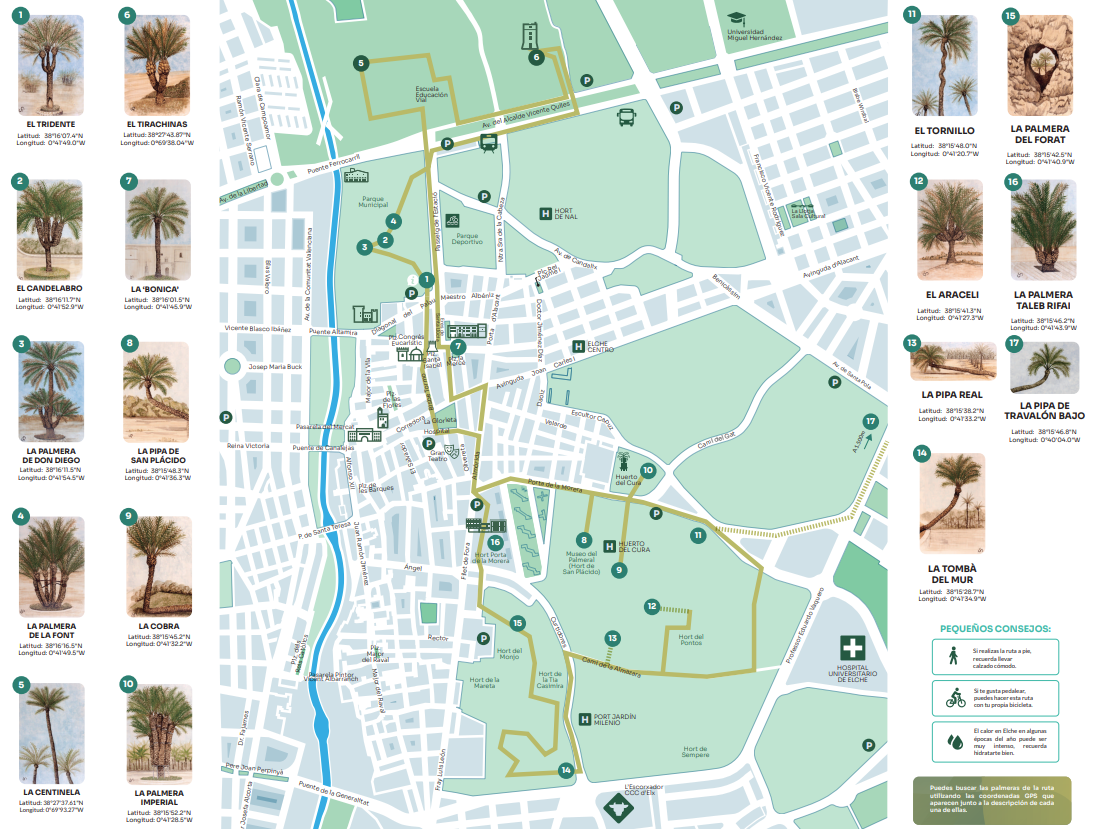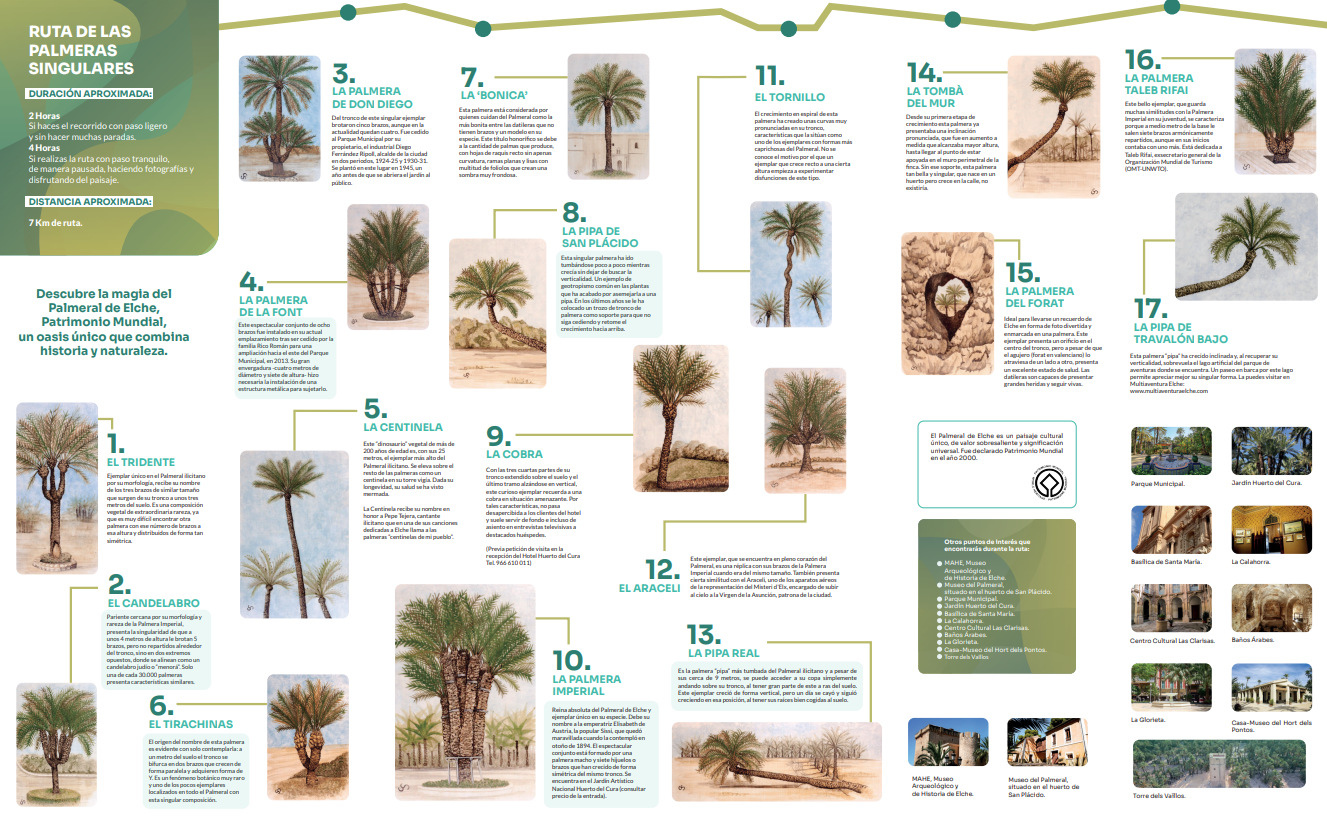THE OUTSTANDING PALM TREE ROUTE
LA PALMERA IMPERIAL (the Imperial Palm Tree)
The absolute queen of the Elche Palm Grove and the only one of its kind, this specimen owes its name to the Empress Elisabeth of Austria, the popular Sissi, who was entranced when she beheld it in the autumn of 1894. This spectacular tree consists of a male date palm with seven suckers or branches that have grown symmetrically from the same trunk.
EL CANDELABRO (the Candelabra)
Closely resembling the Imperial Palm Tree in shape and rarity, the singularity of the Candelabra resides in the fact that five branches emerge at about 4 metres from the ground that are not distributed evenly around the trunk but rather at two opposite sides, forming a Jewish candelabra or “menorah”. Only one in 30,000 palm trees has similar features.
LA PIPA DE SAN PLACIDO (San Placido’s Pipe)
Over the years, the trunk of this exceptional palm has gradually leant further and further towards the ground whilst the top continues to grow upwards. An example of the geotropism common to plants, this palm tree has come to resemble a pipe. In recent years, a section of palm trunk has been put in place to provide support, avoid any further yielding and encourage vertical growth.
EL TRIDENTE (the Trident)
Another unique specimen in the Elche Palm Grove due to its shape, it is named after the three branches of a similar size that sprout from its trunk at about three metres from the ground. This composition is extraordinarily rare in the plant world, and it would be very difficult to find another palm tree with this number of branches at that height and so symmetrically arranged.
EL TIRACHINAS (the Catapult)
The origin of this palm tree’s name becomes evident on sight: one metre above the ground, the trunk divides into two branches that grow parallel to each other, forming a Y-shape. This is a very rare botanical phenomenon and one of the few specimens located throughout the Palm Grove with this unique shape.
EL TORNILLO (the Screw)
The spiralling growth of this palm tree has created pronounced curves in its trunk, a characteristic that renders it one of the most fancifully shaped palm trees in the Grove. It is not known why a specimen that grows vertically should, at a certain height, begin to undergo a dysfunction of this type.
LA ‘BONICA’ (the Beauty)
Those responsible for looking after the Palm Grove consider this the most beautiful of the date palms without branches, and a model of its species. This honorary title is due to the many palm fronds that it produces, with almost completely smooth, flat leaves crowded with leaflets that create a delightfully dappled shade.
LA TOMBÀ DEL MUR (the Wall-leaning Palm Tree)
This palm tree began growing at a strong angle right from the start, an angle that has become more pronounced as it has grown taller, to the point where it now leans against the perimeter wall of the property. Without the support of the wall, this very beautiful and unique palm tree, with its roots in the garden but its crown in the street, would not exist.
EL ARACELI (the Heavenly Altar)
This branching specimen, found in the heart of the Palm Grove, is a replica of the Imperial Palm Tree when it was the same size. It also bears some resemblance to the Araceli, one of the stage machinery devices used in the Elche Mystery Play, which raises Our Lady of the Assumption, patron saint of the city, to heaven.
LA PIPA REAL (the Royal Pipe)
This “pipe” palm tree leans lower than all others of its kind in the Elche Palm Grove: despite having grown almost 9 metres, its crown can be reached merely by walking along its trunk, much of which is at ground level. Although this specimen originally grew upwards, one day it fell and since its roots remained firmly anchored in the ground, it simply continued to grow in that position.
LA COBRA (the Cobra)
Three quarters of its trunk lies upon the ground but the last stretch rises vertically, giving this curious specimen the appearance of a threatening cobra. Its striking aspect is not lost on guests at the hotel, and it often forms the background or even seat in television interviews with prominent clients. To visit, please request permission first at the hotel reception
LA PALMERA DEL FORAT (the Peephole Palm Tree)
An amusing photograph with a palm tree as the frame is the ideal souvenir of Elche. This specimen has a hole in the centre of its trunk, but although the hole (“forat”) runs right through from one side to the other, the tree is in an excellent state of health. Date palms are capable of surviving considerable damage.
LA PALMERA DE DON DIEGO (Don Diego’s Palm Tree)
Five branches originally sprouted from the trunk of this unique specimen, although currently only four remain. It was donated to the Municipal Park by its owner, the industrialist Diego Ferrández Ripoll, twice mayor of the city, in 1924-1925 and 1930-1931. It was planted here in 1945, one year before the garden was opened to the public.
LA PALMERA DE LA FONT (the Fountain Palm Tree)
This spectacular specimen with eight branches was planted in its current location after being donated by the Rico Román family for an extension to the east of the Municipal Park in 2013. Its impressive stature -four metres in diameter and seven metres tall- necessitated the installation of a metal frame to provide it with support.
LA PALMERA TALEB RIFAI (the Taleb Rifai Palm Tree)
Strongly resembling the Imperial Palm Tree when it was young, this beautiful specimen has seven, evenly distributed branches sprouting from its trunk at half a metre from the ground, although in its infancy it had one more. It has been dedicated to Taleb Rifai, Secretary General of the United Nations World Tourism Organisation (UNWTO), of which Elche is a member.
LA PIPA DEL TRAVALÓN BAJO (the Travalón Bajo Pipe)
These two pipe-shaped palm trees stand very close together. Both initially leaned to the side, but as they started growing in a vertical direction, one of them began spiralling in a barley twist fashion. Their unique shapes are best appreciated from a boat on the artificial lake they rise above.
LA CENTINELA (the Sentinel)
Soaring 25 metres above the ground without counting the crown, this 200 year old skyscraper of the plant world is the second tallest specimen in the Palm Grove after the Golondrina (Swallow). This palm tree is named in honour of Pepe Tejera, a singer from Elche who, in one of his songs about Elche, called the palm trees “the sentinels of my town”.


